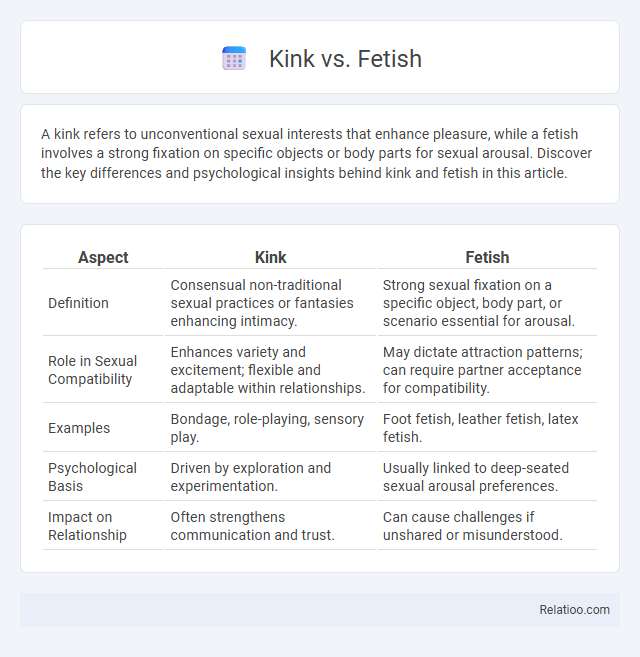A kink refers to unconventional sexual interests that enhance pleasure, while a fetish involves a strong fixation on specific objects or body parts for sexual arousal. Discover the key differences and psychological insights behind kink and fetish in this article.
Table of Comparison
| Aspect | Kink | Fetish |
|---|---|---|
| Definition | Consensual non-traditional sexual practices or fantasies enhancing intimacy. | Strong sexual fixation on a specific object, body part, or scenario essential for arousal. |
| Role in Sexual Compatibility | Enhances variety and excitement; flexible and adaptable within relationships. | May dictate attraction patterns; can require partner acceptance for compatibility. |
| Examples | Bondage, role-playing, sensory play. | Foot fetish, leather fetish, latex fetish. |
| Psychological Basis | Driven by exploration and experimentation. | Usually linked to deep-seated sexual arousal preferences. |
| Impact on Relationship | Often strengthens communication and trust. | Can cause challenges if unshared or misunderstood. |
Understanding the Basics: Kink vs Fetish
Kink refers to unconventional sexual interests or practices that deviate from normative behaviors, encompassing a broad range of activities, while fetish specifically denotes a strong sexual fixation on an inanimate object or particular body part. Understanding the basics of kink versus fetish involves recognizing that kinks are diverse expressions of sexual pleasure and exploration, whereas fetishes are characterized by an essential dependency on the object or focus for sexual arousal. This differentiation is crucial for accurately discussing sexual preferences in psychology, sexology, and relationship dynamics.
Defining Kink: What Does It Encompass?
Kink encompasses a broad range of unconventional sexual interests and behaviors that deviate from traditional norms, often involving power dynamics, role-playing, or specialized equipment. Unlike fetishes, which focus on specific objects or body parts, kink emphasizes activities and experiences that enhance sexual expression and pleasure. Understanding kink helps you explore diverse desires safely and consensually within your intimate relationships.
What is a Fetish? Breaking Down the Term
A fetish refers to a specific object, body part, or activity that an individual finds essential for sexual arousal or satisfaction, distinguishing it from general kink or erotic interests. While kinks involve a broad range of unconventional sexual practices and erotica encompasses sexual content or sensation, a fetish is uniquely characterized by a focused dependency on the fetishized item for sexual excitement. Understanding your fetish can provide insight into your personal sexual preferences and enhance your intimate experiences.
Psychological Origins: Where Do Kinks and Fetishes Come From?
Kinks, fetishes, and erotic preferences often stem from complex psychological origins rooted in early life experiences, neural pathways, and associative learning, where specific stimuli become linked to sexual arousal. Your brain's plasticity plays a crucial role as intimate encounters during formative periods can imprint unique patterns of desire, blending emotional, sensory, and cognitive elements. Understanding these origins allows for a more nuanced view of human sexuality beyond simplistic labels, recognizing how individual histories shape personal erotic interests.
Key Differences Between Kinks and Fetishes
Kinks involve unconventional sexual interests or activities that enhance your pleasure but don't necessarily require specific objects or scenarios, whereas fetishes are characterized by an intense fixation on particular items or body parts essential for sexual arousal. Erotic elements broadly encompass themes or stimuli that provoke sexual excitement, but they lack the distinct behavioral or object-specific focus seen in kinks and fetishes. Understanding these differences can help you better communicate your desires and boundaries in intimate situations.
Common Myths About Kinks and Fetishes
Common myths about kinks and fetishes often confuse them with deviant or harmful behaviors, but in reality, they represent diverse expressions of human sexuality that are safe and consensual. Kink involves unconventional sexual practices or fantasies, while fetishes refer specifically to a strong sexual fixation on non-living objects or specific body parts. Your understanding improves by recognizing that erotic interests vary widely and are healthy when practiced respectfully and with clear consent.
Social Acceptance: Navigating Stigma and Misconceptions
Kinks, fetishes, and erotic interests often face varying levels of social acceptance due to widespread stigma and misconceptions. Understanding these distinctions helps you navigate societal judgments, as kinks typically involve consensual, unconventional sexual preferences, fetishes focus on specific objects or body parts essential for arousal, and erotic experiences encompass a broad range of sexual expressions. Promoting open communication and education fosters greater acceptance and reduces prejudice around these intimate topics.
Safety and Consent in Kink and Fetish Practices
Kink and fetish practices prioritize safety and consent through clear communication, negotiated boundaries, and the use of safe words to ensure all parties feel secure and respected. You must understand the importance of informed consent, continuous check-ins, and aftercare to foster trust and reduce risks during erotic activities. Emphasizing education on physical and emotional safety helps prevent harm and enhances the overall experience within kink and fetish communities.
Communication: Talking Openly About Desires
Open communication about desires is essential in distinguishing kink, fetish, and erotic preferences, ensuring mutual understanding and consent. You can foster trust by discussing boundaries, fantasies, and comfort levels without judgment, which enhances intimacy and safety. Clear dialogue helps partners explore their passions while respecting individual limits and emotional needs within sexual relationships.
Exploring Kink and Fetish in Healthy Relationships
Exploring kink and fetish in healthy relationships promotes open communication, consent, and trust, creating a safe environment for partners to express desires beyond conventional norms. Distinguishing kink as broad unconventional practices and fetish as specific object-focused arousal helps partners understand and respect boundaries. Prioritizing mutual respect and ongoing dialogue enhances intimacy and satisfaction, fostering emotional and physical well-being.

Infographic: Kink vs Fetish
 relatioo.com
relatioo.com